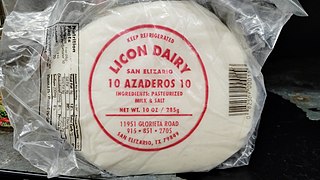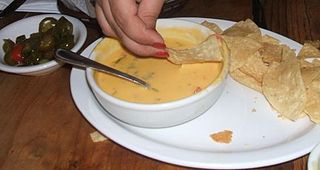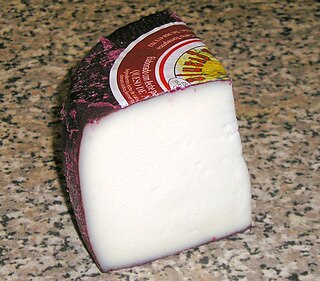
An enchilada is a Mexican dish consisting of a corn tortilla rolled around a filling and covered with a savory sauce. Enchiladas can be filled with various ingredients, including meats, cheese, beans, potatoes, vegetables, or combinations. Enchilada sauces include chili-based sauces, such as salsa roja, various moles, tomatillo-based sauces, such as salsa verde, or cheese-based sauces, such as chile con queso.

Manchego is a cheese made in the La Mancha region of Spain from the milk of sheep of the Manchega breed. It is aged between 60 days and 2 years.

A quesadilla is a Mexican dish consisting of a tortilla that is filled primarily with cheese, and sometimes meats, spices, and other fillings such as chocolate, and then cooked on a griddle or stove. Traditionally, a corn tortilla is used, but it can also be made with a flour tortilla.

Oaxaca cheese, also known as quesillo and queso de hebra, is a white, semihard, low-fat cheese that originated in Mexico. It is similar to unaged Monterey Jack, but with a texture similar to mozzarella or string cheese.

The chile relleno is a dish in Mexican cuisine that originated in the city of Puebla. In 1858, it was described as a "green chile pepper stuffed with minced meat and coated with eggs".

Asadero cheese is a white, flat Mexican cheese that is made fresh from goat and cow's milk. "Asadero" is the kind of cheese, and individual pieces of the cheese are called "asaderos." The milk is mixed with another mixture of milk and rennet and then boiled for thirty minutes. The mixture is churned, cooked again and then flattened into flat, round shapes while it is still hot. It is a mild cheese that melts well. It is often eaten with bread or tortillas. Asadero is sometimes confused with Chihuahua and Oaxaca cheeses.

Chile con queso, sometimes simply called queso, is an appetizer or side dish of melted cheese and chili peppers, typically served in Tex-Mex restaurants as a dip for tortilla chips.

Cotija is an aged Mexican cheese made from cow's milk and named after the town of Cotija, Michoacán. White in color and firm in texture, its flavor is salty and milky. "Young" cotija cheese has been described as akin to a mild feta, while aged (añejo) cotija is more comparable in flavor to hard, aged cheeses like Parmesan. Cotija softens when exposed to heat, but does not melt. Made between the summer and fall seasons; this cheese is made with milk from local cattle and is salted before the fermentation process. The manufacturing processes of most cheeses in Mexico are still rustic and traditional, similar to the manufacturing process that was used upon its invention. Due to the traditional means of production of dairy products in Mexico some dairy products have a conflicting shelf-life which leads to earlier expiration. However, some studies suggest components in the fermentation of Cotija Cheese are natural preservatives that can extend the shelf-life of Cotija Cheese and other food products as well.

Criollo is a grateable Mexican cheese similar to Munster cheese. It is a specialty of the region around Taxco, Guerrero. It is one of the few yellow cheeses made in Mexico.
White cheese includes a wide variety of cheese types discovered in different regions, sharing the sole common characteristic of their white hue. The specific type of white cheese can vary significantly depending on the geographical location.

Pambazo is a Mexican dish or antojito made with pambazo bread dipped and fried in a red guajillo pepper sauce. It is traditionally filled with papas con chorizo or with papas only but there are different varieties.

Queso panela is a fresh cheese common in Mexico made from pasteurized cow's milk. It is also known as queso canasta or queso de la canasta. It is derived from the Greek word for basket cheese. The cheese also has similarities to the Indian cheese paneer.

According to a 2022 census, there were 74,122 Mennonites living in Mexico, the vast majority of which are established in the state of Chihuahua, followed by Campeche at around 15,000, with the rest living in smaller colonies in the states of Durango, Tamaulipas, Zacatecas, San Luis Potosí and Quintana Roo.

Queso flameado is a dish of hot melted cheese and spicy chorizo that is often served flambé. Often compared to cheese fondue, it is a party dish; it is popular at cookouts and in restaurants as an appetizer. Almost unique in Mexican cuisine, in the cuisine of the United States this dish has been widely adapted and is considered a native dish in El Paso. In Mexico, it occurs in restaurants more often in the north. Typical main ingredients are melted cheese and a characteristic meat sauce of loose fresh chorizo, tomato, onion, chile and spices. It is served in a small, shallow casserole or other ceramic or metal heat-proof baking dish. The cheese and sauce are prepared separately, and combined just before serving. This may be done at the table, especially if finished with a flambé: high alcohol liquor is poured on the cheese and ignited, and as it burns the server folds in the sauce. If not flambéed, the mixture may be quickly broiled. Either way, the finished dish is presented while it is still bubbling hot, and it is spooned onto small soft tortillas for individual servings.

Cheeses in Mexico have a history that begins with the Spanish conquest, as dairy products were unknown in pre-Columbian Mesoamerica. The Spanish brought dairy animals, such as cattle, sheep, and goats, as well as cheesemaking techniques. Over the colonial period, cheesemaking was modified to suit the mixed European and indigenous tastes of the inhabitants of New Spain, varying by region. This blending and variations have given rise to a number of varieties of Mexican cheeses. These are most popular in the country, although European cheeses are made, as well. Almost all cheese in Mexico is made with cows’ milk, with some made from goats’ milk. More recently, efforts have been made to promote sheep's milk cheeses. Most cheeses are made with raw (unpasteurized) milk. Cheeses are made in the home, on small farms or ranches, and by major dairy product firms. Between 20 and 40 different varieties of cheese are made in Mexico, depending on how one classifies them. Some, such as Oaxaca and panela, are made all over Mexico, but many are regional cheeses known only in certain sections on the country. Some of the least common are in danger of extinction.
Murcian cheese is a fatty goats' milk cheese from the Murcia region of south-east Spain. It has a Protected Designation of Origin. The cheese is made exclusively using goat's milk of the Murcian breed from registered herds which graze freely on scrub and coarse pasture characteristic of that dry geographical zone. The cheese is made in two forms:

Murcian wine cheese is a fatty goats’ milk cheese from the province of Murcia in the south-east of Spain. It has a Protected Designation of Origin. The cheese is made only from unpasteurized goats’ milk of the Murcian breed from registered herds. The term al vino refers to the washing of the rind with red wine during maturation. The cheese is presented in cylinders 6–7 cm (2-3 inches) high and 7–9 cm (3-4 inches) diameter weighing 400 g, or 7–9 cm (3-4 inches) high and 12–18 cm (5-7 inches) diameter weighing 1 kg (2.2 lbs) or 2 kg (4.4 lbs).

Mennonite cuisine is food that is unique to and/or commonly associated with Mennonites, a Christian denomination that came out of sixteenth-century Protestant Reformation in Switzerland and the Netherlands. Because of persecution, they lived in community and fled to Prussia, Russia, North America, and Latin America. Groups like the Russian Mennonites developed a sense of ethnicity, which included cuisine adapted from the countries where they lived; thus, the term "Mennonite cuisine" does not apply to all, or even most Mennonites today, especially those outside of the traditional ethnic Mennonite groups. Nor is the food necessarily unique to Mennonites, most of the dishes being variations on recipes common to the countries where they reside or resided in the past.

A marquesita is a dessert native to the state of Yucatán, Mexico. It consists of a crepe, rolled like a taco, filled with cajeta, condensed milk, jam, chocolate or edam cheese, also known as queso de bola. They are sold in squares, parks and streets.

Argentine cheese is by far the most produced dairy product in the country, making Argentina the second largest cheese producer in Latin America and among the top 10 cheese-producing countries in the world. In addition, Argentina is the Latin American country that consumes the most cheese, with 12 kilos per capita per year. Production is mainly centered in the provinces of Córdoba, Santa Fe and Buenos Aires, in the Pampas region of the central and east-central parts of the country.


















